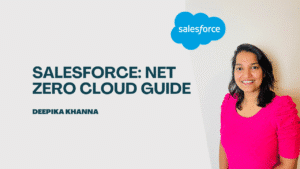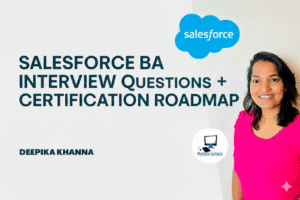Sustainability is now an important part of running a successful business. People today want to do business with companies that are both new and good for the environment. Carbon emissions rules are getting stricter, and investors are putting more weight on ESG (Environmental, Social and Governance) measures. Companies are starting to understand that sustainability should not just be a part of supply lines or factories; it should be a part of every part of the business, even customer relationship management (CRM).

This is where Salesforce Net Zero Cloud comes in. It is not just a carbon accounting tool; it’s a full platform that gives companies the power to make sustainability a part of how they deal with customers, how they report and how they plan for the future. This blog post will talk about how Salesforce Net Zero Cloud makes sustainable CRM practices possible, what its benefits are and how businesses can use it successfully.
Table of Contents
ToggleWhat are Sustainable CRM practices?
Sustainable CRM means that businesses use eco-friendly methods and data-driven insights to handle their interactions with customers. The main goals of traditional CRM systems are sales, marketing and customer service. But in the world we live in now, these interactions also need to show how sustainable a company is.
For instance, when a company handles its entire customer lifecycle digitally instead of using paper-based methods, it not only works better but also wastes less. In the same way, the CRM directly helps reach sustainability goals when customer insights are used to find out what green goods, or services people want. Sustainable CRM practices make sure that both business growth, and climate change happen at the same time by balancing the needs of customers with the needs of the environment.
Understanding Salesforce Net Zero Cloud
An environmental management tool called Salesforce Net Zero Cloud can be used to track, analyse and report carbon emissions. Amounts of Scope 1, Scope 2 and Scope 3 emissions are tracked, and the information is shown in screens that follow international standards like GRI, CDP and TCFD.

The tool does more than just track. It also makes it easy for organisations to make sustainability reports, model what might happen in the future and see how business decisions affect their carbon footprint. Net Zero Cloud connects easily to customer data because it is built into the Salesforce ecosystem. This means that sustainability can be a part of talks with customers and business planning.
Why Sustainable CRM is More Important Than Before?
These days, businesses can not just throw sustainability together at the last minute. Adding sustainability to CRM tools has real benefits for businesses:

- Compliance with regulations: Companies need correct and auditable sustainability data as new global rules require them to disclose climate information. Integrating Net Zero Cloud makes sure compliance without adding more work to be done by hand.
- Expectations of the Customer: Customers who care about the environment like brands that are open about how they treat the environment. Being environmentally friendly in your CRM messages can help build trust with customers a lot.
- Investor Confidence: More and more investors look at ESG success before putting money into a company. Companies that can show sustainability metrics right in their reporting tools stand out.
- Operational Savings: Going green often means finding inefficiencies, like too much travel, wasteful planning or energy use that isn’t needed. Taking care of these places lowers costs and emissions.
- Reputation Management: In the long run, brands that are leaders in sustainability will be better able to draw employees, customers, and business partners.
Sustainable CRM Methods with Salesforce Net Zero Cloud
Carbon accounting has been integrated into CRM workflows.
Most of the time, traditional carbon tracking is not linked to how a business runs. This is different with Salesforce Net Zero Cloud because it builds carbon accounting right into CRM processes. Companies can connect information about pollution to customer accounts, which lets clients talk about sustainability. For instance, a company that makes things can show their customers info on emissions related to their supply chain. This shows that they are open, and responsible.
Use of sustainability dashboards to get customers involved
Sustainability can be a big deal when it comes to getting new customers. With Net Zero Cloud, companies can give their customers personalised dashboards that show how far they’ve come in terms of reducing waste, using green energy or becoming carbon neutral. These accomplishments can also be included in proposals by sales teams. This will boost the company’s image as eco-friendly, and increase customer trust.
Making supply chains more eco-friendly
A company’s supply lines are often where most of its carbon emissions come from, especially Scope 3 emissions. Net Zero Cloud lets companies check how sustainable their suppliers are and use that information to make decisions. This means that companies can give more weight to suppliers with lower pollution, encourage sustainable practices all along the supply chain and be open with their customers about these efforts.
Reporting on ESG and compliance automatically
Meeting all the different reporting standards is one of the hardest parts of sustainability. Net Zero Cloud makes this easier by providing automatic ESG reporting tools that are in line with standards like CDP, GRI and TCFD. Instead of putting together data by hand, businesses can make reports that are ready for compliance in real time, which saves time and makes sure the information is correct. The greater openness is good for both customers, and regulators.
Using insights into sustainability to drive innovation
Sustainability is not just about following the rules, it can also lead to new products, and services. Businesses can see that there is a growing demand for eco-friendly goods by looking at both customer data, and sustainability metrics. For example, a store could use these insights to come up with low-carbon delivery choices, or packaging that can be recycled, which would be in line with what customers want, and what the market is doing.
Minimising CRM’s own impact on the environment
Cloud-native platforms like Salesforce already use renewable-powered data centres to save energy. Businesses do not need resource intensive on premises infrastructure when they use Net Zero Cloud. This lowers their IT-related carbon footprint, and takes advantage of Salesforce’s pledge to net-zero operations.
Benefits of Salesforce Net Zero Cloud for Sustainable CRM
When businesses use Salesforce Net Zero Cloud, they get both concrete, and intangible benefits:

- Accurate and Centralised Emissions Tracking: Businesses get a single source of truth for all emissions data, including data from their own operations, energy purchases and actions in the supply chain.
- Streamlined Compliance: Aligning automatically with frameworks like GRI and SEC climate disclosure saves time and cuts down on mistakes in filing.
- Cost savings from efficiency gains: Finding waste in areas like travel, energy use or operations can lead to real savings.
- Data-Driven Decision Making: Leaders can choose the actions that will have the biggest effect on sustainability by using insights powered by AI.
Best Practices for Implementing Sustainable CRM with the Net Zero Cloud
To get the most out of Salesforce Net Zero Cloud, businesses should take a planned approach:
- Make a baseline assessment: Start by looking at how you handle emissions and ecology now. This sets a standard that can be used to measure future progress.
- Add sustainability to all of your CRM processes: Make sure that tracking emissions, reporting them and getting information about sustainability are not kept separate but are part of the processes that customers see. This makes it easier for the service, marketing and sales teams to use sustainability as a key way to get people interested.
- Set Clear and Achievable Goals: Come up with both short-term, and long-term goals for sustainability that are in line with global agreements like the Paris Agreement. Setting goals in a clear way builds trust among stakeholders.
- Use Real-Time Monitoring and Continuous Improvement: The tools in Net Zero Cloud let you keep an eye on progress all the time. Share reports with people who matter, change your plans based on what you learn and think of sustainability as a journey, not a one-time job.
Conclusion
The area where CRM and sustainability meet is one of the most exciting new areas in business change. Businesses can make their customer interactions, reports and strategies more sustainable by using Salesforce Net Zero Cloud. This helps them cut down on pollution, follow the rules and build trust with customers, all while improving working efficiency.
Sustainable CRM practices are not just about being better for the environment, they are a way of doing business that takes into account both customer satisfaction and protecting the environment. Businesses that are looking to the future know that using Salesforce Net Zero Cloud is more than just an investment in technology. It is a promise to build a strong, responsible and future-ready brand.
Bottom Line
Salesforce Net Zero Cloud is more than just a way to keep track of carbon emissions; it’s also a way to build long-lasting CRM practices that balance growth, safety, and caring for the environment. Businesses can cut down on emissions, build trust, and make sure their brand will be around in the future by making every contact with customers more sustainable.
Platforms like Mytutorialrack, run by Salesforce trainer Deepika Khanna, offer structured courses, real-world projects, and mentorship to help professionals master Salesforce solutions, such as Net Zero Cloud, and stand out as experts making a difference in the changing CRM landscape.






